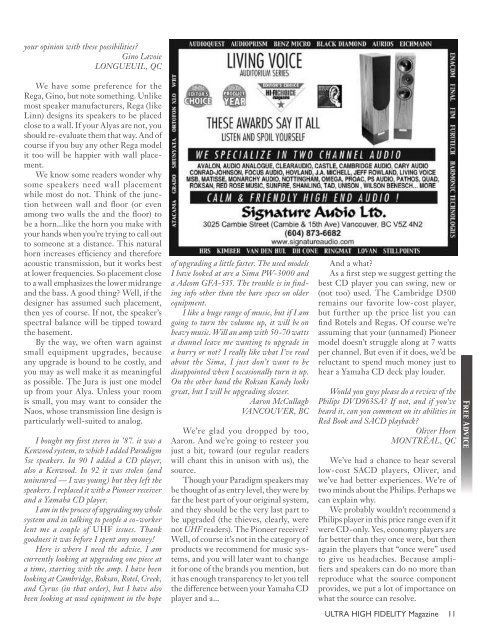download the PDF version - Ultra High Fidelity Magazine
download the PDF version - Ultra High Fidelity Magazine
download the PDF version - Ultra High Fidelity Magazine
You also want an ePaper? Increase the reach of your titles
YUMPU automatically turns print PDFs into web optimized ePapers that Google loves.
Free Advice<br />
your opinion with <strong>the</strong>se possibilities?<br />
Gino Lavoie<br />
LONGUEUIL, QC<br />
We have some preference for <strong>the</strong><br />
Rega, Gino, but note something. Unlike<br />
most speaker manufacturers, Rega (like<br />
Linn) designs its speakers to be placed<br />
close to a wall. If your Alyas are not, you<br />
should re-evaluate <strong>the</strong>m that way. And of<br />
course if you buy any o<strong>the</strong>r Rega model<br />
it too will be happier with wall placement.<br />
We know some readers wonder why<br />
some speakers need wall placement<br />
while most do not. Think of <strong>the</strong> junction<br />
between wall and floor (or even<br />
among two walls <strong>the</strong> and <strong>the</strong> floor) to<br />
be a horn...like <strong>the</strong> horn you make with<br />
your hands when you’re trying to call out<br />
to someone at a distance. This natural<br />
horn increases efficiency and <strong>the</strong>refore<br />
acoustic transmission, but it works best<br />
at lower frequencies. So placement close<br />
to a wall emphasizes <strong>the</strong> lower midrange<br />
and <strong>the</strong> bass. A good thing? Well, if <strong>the</strong><br />
designer has assumed such placement,<br />
<strong>the</strong>n yes of course. If not, <strong>the</strong> speaker’s<br />
spectral balance will be tipped toward<br />
<strong>the</strong> basement.<br />
By <strong>the</strong> way, we often warn against<br />
small equipment upgrades, because<br />
any upgrade is bound to be costly, and<br />
you may as well make it as meaningful<br />
as possible. The Jura is just one model<br />
up from your Alya. Unless your room<br />
is small, you may want to consider <strong>the</strong><br />
Naos, whose transmission line design is<br />
particularly well-suited to analog.<br />
I bought my first stereo in ’87. it was a<br />
Kenwood system, to which I added Paradigm<br />
5se speakers. In 90 I added a CD player,<br />
also a Kenwood. In 92 it was stolen (and<br />
uninsured — I was young) but <strong>the</strong>y left <strong>the</strong><br />
speakers. I replaced it with a Pioneer receiver<br />
and a Yamaha CD player.<br />
I am in <strong>the</strong> process of upgrading my whole<br />
system and in talking to people a co-worker<br />
lent me a couple of UHF issues. Thank<br />
goodness it was before I spent any money!<br />
Here is where I need <strong>the</strong> advice. I am<br />
currently looking at upgrading one piece at<br />
a time, starting with <strong>the</strong> amp. I have been<br />
looking at Cambridge, Roksan, Rotel, Creek,<br />
and Cyrus (in that order), but I have also<br />
been looking at used equipment in <strong>the</strong> hope<br />
of upgrading a little faster. The used models<br />
I have looked at are a Sima PW-3000 and<br />
a Adcom GFA-535. The trouble is in finding<br />
info o<strong>the</strong>r than <strong>the</strong> bare specs on older<br />
equipment.<br />
I like a huge range of music, but if I am<br />
going to turn <strong>the</strong> volume up, it will be on<br />
heavy music. Will an amp with 50-70 watts<br />
a channel leave me wanting to upgrade in<br />
a hurry or not? I really like what I’ve read<br />
about <strong>the</strong> Sima, I just don’t want to be<br />
disappointed when I occasionally turn it up.<br />
On <strong>the</strong> o<strong>the</strong>r hand <strong>the</strong> Roksan Kandy looks<br />
great, but I will be upgrading slower.<br />
Aaron McCullagh<br />
VANCOUVER, BC<br />
We’re glad you dropped by too,<br />
Aaron. And we’re going to resteer you<br />
just a bit, toward (our regular readers<br />
will chant this in unison with us), <strong>the</strong><br />
source.<br />
Though your Paradigm speakers may<br />
be thought of as entry level, <strong>the</strong>y were by<br />
far <strong>the</strong> best part of your original system,<br />
and <strong>the</strong>y should be <strong>the</strong> very last part to<br />
be upgraded (<strong>the</strong> thieves, clearly, were<br />
not UHF readers). The Pioneer receiver?<br />
Well, of course it’s not in <strong>the</strong> category of<br />
products we recommend for music systems,<br />
and you will later want to change<br />
it for one of <strong>the</strong> brands you mention, but<br />
it has enough transparency to let you tell<br />
<strong>the</strong> difference between your Yamaha CD<br />
player and a...<br />
And a what?<br />
As a first step we suggest getting <strong>the</strong><br />
best CD player you can swing, new or<br />
(not too) used. The Cambridge D500<br />
remains our favorite low-cost player,<br />
but fur<strong>the</strong>r up <strong>the</strong> price list you can<br />
find Rotels and Regas. Of course we’re<br />
assuming that your (unnamed) Pioneer<br />
model doesn’t struggle along at 7 watts<br />
per channel. But even if it does, we’d be<br />
reluctant to spend much money just to<br />
hear a Yamaha CD deck play louder.<br />
Would you guys please do a review of <strong>the</strong><br />
Philips DVD963SA? If not, and if you’ve<br />
heard it, can you comment on its abilities in<br />
Red Book and SACD playback?<br />
Oliver Hoen<br />
MONTRÉAL, QC<br />
We’ve had a chance to hear several<br />
low-cost SACD players, Oliver, and<br />
we’ve had better experiences. We’re of<br />
two minds about <strong>the</strong> Philips. Perhaps we<br />
can explain why.<br />
We probably wouldn’t recommend a<br />
Philips player in this price range even if it<br />
were CD-only. Yes, economy players are<br />
far better than <strong>the</strong>y once were, but <strong>the</strong>n<br />
again <strong>the</strong> players that “once were” used<br />
to give us headaches. Because amplifiers<br />
and speakers can do no more than<br />
reproduce what <strong>the</strong> source component<br />
provides, we put a lot of importance on<br />
what <strong>the</strong> source can resolve.<br />
ULTRA HIGH FIDELITY <strong>Magazine</strong> 11
















